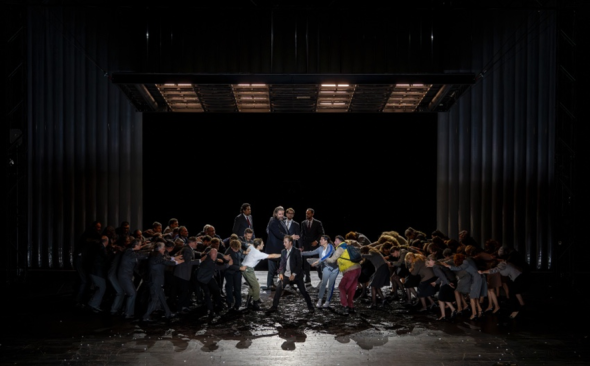 Spain Mozart, Die Zauberflöte: Soloists, Generalitat Valenciana Chorus, Comunitat Valenciana Orchestra / James Gaffigan (conductor). Palau de les Arts Reina Sofía, Valencia, 8.6.2024. (JMI)
Spain Mozart, Die Zauberflöte: Soloists, Generalitat Valenciana Chorus, Comunitat Valenciana Orchestra / James Gaffigan (conductor). Palau de les Arts Reina Sofía, Valencia, 8.6.2024. (JMI)

Production:
Stage director – Simon McBurney
Set designer – Michael Levine
Costume designer – Nicky Gillibrand
Lighting designer – Jean Kalman
Video designer – Finn Ross
Sound designer – Gareth Fry
Chorus master – Francesc Perales
Cast:
Sarastro – Matthew Rose
Tamino – Giovanni Sala
Speaker – Irakli Pkhaladze
Priests / Armed Men – Alejandro López, Jorge Franco
Queen of the Night – Rainelle Krause
Pamina – Serena Sáenz
Three Ladies – Antonella Zanetti, Laura Fleur, Luzia Tietze
Three Boys – members of Trinity Boys Choir
Papagena – Iria Goti
Papageno – Gyula Orendt
Monostatos – Brenton Ryan
Palau de Les Arts is ending the season with this Mozart opera, one of the most popular in the repertoire. It was last seen in Valencia in 2013, when it also closed the opera season. The current performance was a winner, in terms of both theatre attendance and the audience’s reaction.
Undoubtedly, a key aspect in the triumph has to do with Simon McBurney’s staging – a Dutch National Opera, Festival d’Aix-en-Provence and English National Opera coproduction – which premiered in Amsterdam in 2012 and has been extremely successful. One could say that the productions by Barrie Kosky and Simon McBurney are the true standards for The Magic Flute, at least in recent years.

The stage is almost bare – the key elements are a large platform in the center and a screen at the back. The platform changes shape and elevation frequently: sometimes the plot develops on it, while on other occasions the action takes place below it or at the front of the stage. The screen displays attractive, well-projected images, from the mountainous landscape with which the opera opens to images of places like the palace or Sarastro’s sanctuary and the like.
The direction is imaginative, with the action brought to the present time in terms of the costumes. Act I is a succession of oddities that powerfully attract one’s attention, but you get used to them. It is curious that the Queen of the Night is played as an old woman in a wheelchair, and that the children accompanying Tamino are disguised as old people. In the second act, there were some notable scenes too, including Papageno with bottles instead of bells. But to sum up, it is an excellent production.
Conductor James Gaffigan, the current musical director of the Komische Oper in Berlin, offered a convincing reading, particularly in the first part. He has become a decisive musical force in Valencia. As always, the Valencia orchestra was impressive, and the same can be said of the chorus.
Tamino was performed by tenor Giovanni Sala, who has been heard in Valencia on earlier occasions. He has a strong voice and sang with gusto. Soprano Serena Sáenz was Pamina, and she has been a frequent interpreter of the character in recent years. I have heard her in the role several times, and she has always been noteworthy. Her admirable voice carries throughout the opera house.
Baritone Gyula Orendt was outstanding as Papageno, giving life and voice to the bird catcher. Sarastro was bass Matthew Rose who has an ample voice, although one misses the deep notes of other Sarastros of recent times, especially from René Pape on top form. In any case, Rose did well.
The Queen of the Night was soprano Rainelle Krause, a light soprano who is familiar with the character. She clearly stands out in coloratura and in the high notes, although she is somewhat weak in the lower register. After her aria in Act II, she received the biggest ovation of the night.
Iria Goti was fine as Papagena, and so too was Irakli Pkhaladze as the Speaker. I was less impressed by the Monostatos of tenor Brenton Ryan. The Three Ladies, played by Antonella Zanetti, Laura Fleur and Luzia Tietze, were excellent, as were the Three Boys (here old men) who belong to the Trinity Boys Choir.
José M. Irurzun
